#austral africa
Photo
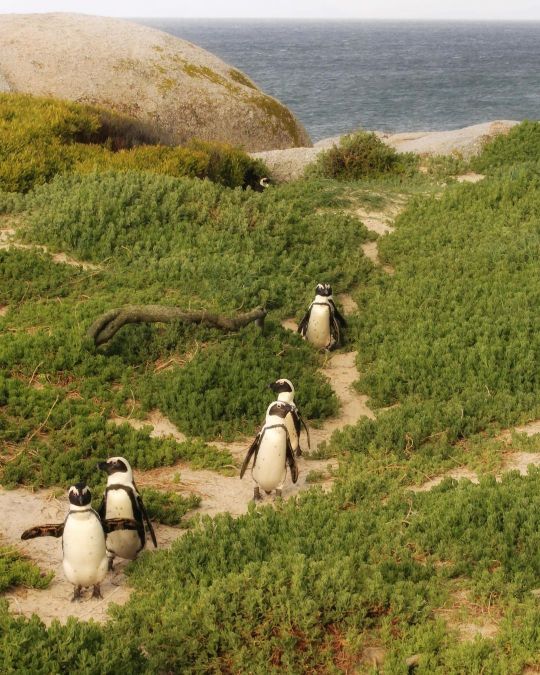
Le manchot du Cap peut mesurer entre 60 et 70 cm et pèse entre 2 et 4 kg. Les petits ont le corps recouvert d’un fin duvet gris, lequel tombe durant la puberté (entre 12 et 22 mois) pour laisser place à leur plumage d’adulte. Le manchot du Cap est une espèce endémique d’Afrique australe. Le manchot du Cap est une espèce monogame. Au début du XIXème siècle, on estime que la population de manchots du Cap s’élevait à environs 4 millions d’individus. Ils seraient à peine plus de 55 000 aujourd’hui, leur population ayant presque été réduite à néant par l’activité humaine. Il s’agit désormais d’une espèce protégée classée sur la liste rouge des espèces menacées par l’IUCN . The Cape penguin can measure between 60 and 70 cm and weigh between 2 and 4 kg. The young have their bodies covered with a fine gray down, which falls during puberty (between 12 and 22 months) to give way to their adult plumage. The African penguin is endemic to southern Africa. The African penguin is a monogamous species. At the beginning of the 19th century, it is estimated that the population of Cape penguins amounted to around 4 million individuals. They would be just over 55,000 today, their population having been almost wiped out by human activity. It is now a protected species listed on the IUCN Red List of Threatened Species. . #southafrica #southafrica🇿🇦 #afriquedusud #afrique #africa #manchot #pinguin #beach #capetownsouthafrica #travel #travelphotography #travelgram #travelblogger #travels #voyage #voyageursdumonde #national_geography #nature #naturephotography #naturerey #naturelovers #animales #animallovers #animal #birds #bird #summer #summervibes #goodvibes #happy (à Cap of Good Hope) https://www.instagram.com/p/Cpmr7ldsoro/?igshid=NGJjMDIxMWI=
#southafrica#southafrica🇿🇦#afriquedusud#afrique#africa#manchot#pinguin#beach#capetownsouthafrica#travel#travelphotography#travelgram#travelblogger#travels#voyage#voyageursdumonde#national_geography#nature#naturephotography#naturerey#naturelovers#animales#animallovers#animal#birds#bird#summer#summervibes#goodvibes#happy
55 notes
·
View notes
Text
You know what, it's April fool's day so I'm letting go of all my worries about how this insane rambling will look like cause IT'S TIME TO TALK ABOUT THE ZULU KINGDOM BABY
What is the Zulu kingdom? It is a African kingdom located in Austral Africa, founded in 1816 by the first king Shaka Zulu (also called Shaka kaSenzangakhona).
This kingdom stayed independent until 1879, when the Anglo Zulu war saw the British empire take control of the state, but before this, the Zulu kingdom had an enormous impact on Southern Africa as a whole, both in terms of geography, culture and warfare.
To explain this, let's go back to the foundation of the kingdom. At the time, the Zulus were not a kingdom, but a tribe. Shaka Zulu, who was one of the numerous children of the tribe leader Senzangakhona, took power after his death and set out to do numerous reforms to the way of life of the Zulus, which would turn crucial to the tribe's transition into one of the most fearsome military states of its time.
The first reforms were in weaponry: while the Zulus, like other tribes of the region, used mainly spears to fight, Shaka introduced new ways of fighting with the iklwa (an assegai which would play a role similar to a sword) and the isihlangu (a 2 meter tall cow hide shield perfect to shield Zulu soldiers from enemy spears). With those, the strategy would be to rush towards the enemy lines, who still used spears, and go into hand to hand combat where the iklwa were superior.
Shaka Zulu also introduced new military tactics, which were never seen before in Southern Africa -owning him the nickname of "the African Napoleon"-, though the one he is the most well known for is the bullhorn strategy. This tactic would separate the army in three contingents: the horns, formed of the younger soldiers whose role would be to deploy quickly and circle the enemies as to stop them from running; the chest, the main force which would then hit the enemy (in a hammer and anvil formation similar to those of Alexander the Great); and the loin, a special force staying behind and ready to intervene wherever they would be needed, wether it was finishing off fleeing enemies, helping a struggling group or assisting in the retreat.
All of this lead the Zulus to easily beat and take control of the neighboring tribes and states, in an event knows as the Mfecane (crushing in Zulu), where people would flee the Zulu menace and bring in their escape the Zulu strategies, which in turn would make them a danger to the people they were fleeing into. But not everyone fled, and a lot of tribes became integrates into Zulu society.
This is where we can see Shaka Zulu's reforms of the military to their full extent: the first thing he did with it was to organize the military into ranks based on veterance. As said before, the youngest soldiers would form the horns, and the oldest the chest. Another thing was that every group of soldier (the impi) was to be formed of men from different tribes. This way, a feeling of unity would form that would stop the conquered groups from wanting to revolt.
By doing this, Shaka Zulu created a sentiment of Zulu identity even in groups originally not Zulu, which would stay up to this day.
And that is how the Zulu kingdom came to be! Through the numerous reforms and military genius of Shaka Zulu, was born a brand new actor in Southern Africa, one that would one day inflicts to the British their worst defeat in a war of colonization- but that's for another time!
3 notes
·
View notes
Text
Sack Man
The Sack Man (also called the Bag Man or Man with the Bag/Sack) is a figure similar to the bogeyman, portrayed as a man with a sack on his back who carries naughty children away.
Variants of this figure appear all over the world, particularly in Latin countries, such as Spain, Portugal, Italy (where he is known as the vecchio col sacco ("the old man with the sack"), and the countries of Latin America, where it is referred to as el "Hombre del costal", el hombre del saco, or in Portuguese, o homem do saco (all of which mean "the sack/bag man"), and Eastern Europe. Similar legends are found in Haiti and some countries in Asia.

In Spain, el hombre del saco is usually depicted as a mean and impossibly ugly and skinny old man who eats the misbehaving children he collects. The crime of Gádor gave rise to this term because the kidnapers used a gunny sack to carry with the children. In Brazil, o homem do saco is portrayed as a tall and imposing adult male, usually in the form of a vagrant, who carries a sack on his back, and collects mean disobedient children for nefarious purposes. In Chile, Argentina and particularly in the Southern and Austral Zones, is mostly known as "El Viejo del Saco" ("The old man with the bag") who walks around the neighbourhood every day around supper time. This character is not considered or perceived as a mythical or fantastic creature by children. Instead, he is recognised as an insane murderer that somehow has been accepted by society which allows him to take a child that has been given to him willingly by disappointed parents or any child that is not home by sundown or supper time. In Honduras and Mexico, misbehaving children fear "El Roba Chicos", or child-snatcher, which is very similar to "Hombre del Saco".
In Armenia and Georgia, children are threatened by the "Bag Man" who carries a bag and kidnaps those who do not behave. In Hungary, the local bogeyman, the mumus, is known as zsákos ember, literally "the person with a sack". In Poland children are frightened by the bebok, babok, or bobok or who is also portrayed as a man with a sack. In the Czech Republic and Slovakia, a similar creature is known: bubák. It's a creature without a typical form, connected with darkness or scary places, making children fear but not taking them away usually. The character of čert, the devil, is used for that instead ("Don't be naughty or čert will take you away!"). In Russia, Ukraine and Belarus, buka ("бука"), Babay ("бабай") or Babayka ("бабайка") is used to keep children in bed or stop them from misbehaving. 'Babay' means "old man" in Tatar. Children are told that "Babay" is an old man with a bag or a monster, usually hiding under the bed, and that he will take them away if they misbehave (though he is sometimes depicted as having no set appearance).
In North India, children are sometimes threatened with the Bori Baba or "Father Sack" who carries a sack in which he places children he captures. A similar being, "Abu i Kees" (ابو كيس), literally "The Man with a Bag", appears in Lebanon.] In Turkey, Kharqyt (Turkish: Harkıt means "Sack Man"- also called Öcü, Böcü or Torbalı) is portrayed as a man with a sack on his back who carries naughty children away to eat or sell them.
In Korea, mangtae yeonggam (망태 영감) an old man (yeonggam) who carries a mesh sack (mangtae) to put his kidnapped children in, thus, "Old Man with a Sack". In some regions, mangtae yeonggam is replaced by mangtae halmeom (망태 할멈), an old woman with a mesh sack. In Vietnam, misbehaving children are told that ông ba bị (in the North; literally mister-three-bags) or ông kẹ (in the South) will come in the night and take them away.
In Sri Lanka, among the Sinhalese people, elders frighten misbehaving children with Goni Billa, (translates roughly as "sack kidnapper") a scary man carrying a sack who arrives day or night to capture and keep children.
In the Western Cape folklore of South Africa, Antjie Somers is a Bogeyman who catches naughty children in a bag slung over his shoulder. Although the name is that of a female, Antjie Somers is traditionally a male figure.
Several countries contrast their version of the sack man with the benign sack carrier Father Christmas. In the Netherlands and Flanders, Zwarte Piet (Dutch for "Black Pete") is a servant of Sinterklaas, who delivers bags of presents on December 5 and takes naughty kids back to Spain in the now empty bags.
In some stories, the Zwarte Piets themselves were kidnapped as kids, and the kidnapped kids make up the next generation of Zwarte Piets. In Switzerland, the corresponding figure is known as Schmutzli (derived from Butzli) in German, or Père Fouettard in French.
A similar figure, Krampus, appears in the folklore of Alpine countries, sometimes depicted with a sack or washtub to carry children away. In Bulgaria, children are sometimes told that a dark scary monster-like person called Torbalan (Bulgarian: Торбалан, which comes from "торба", meaning a sack, so his name means "Man with a sack") will come and kidnap them with his large sack if they misbehave. He can be seen as the antipode of the Christmas figure Santa Claus (Bulgarian: Дядо Коледа; corresponding to Father Christmas).
In Haiti, the Tonton Macoute (Haitian Creole: Uncle Gunnysack) is a giant, and a counterpart of Father Christmas, renowned for abducting bad children by putting them in his knapsack. During the dictatorship of Papa Doc Duvalier, certain Haitian secret policemen were given the name Tontons Macoutes because they were said also to make people disappear.
5 notes
·
View notes
Photo

Racing Dunes in Namibia Sculpted by time and fierce Atlantic winds, the Namib sand sea has been on the move for a million years and counting. The fast-moving sands blanket a region of Africa’s southwestern coast where treasures—from diamonds and ghost towns to rare and endangered species—have long captured human imaginations. The rapid movement of the dunes is clear in this series of Landsat 8 and 9 images acquired between 2013 and 2022 (one scene per year). The images show a group of crescent-shaped barchan dunes and more linear transverse dunes located in the Sperrgebiet region of the southern Namib desert. The dunes have migrated northward by several kilometers in recent decades, driven primarily by the region’s persistent south-southwest winds. Researchers from the Desert Research Institute and the Smithsonian Institution used satellite observations from the Advanced Spaceborne Thermal Emission and Reflection Radiometer (ASTER) on NASA’s Terra satellite to study the motion of the dunes over an eight-year period and found that the average rate at which the dunes in this area moved ranged from 7 to 32 meters (23 to 105 feet) per year. Large dunes tended to preserve their shape, moving at an average of about 9 meters per year, according to the researchers. Some of the smaller dunes were much faster, with some moving as quickly as 83 meters (272 feet) per year. Unlike the larger dunes, the smaller dunes tended to appear and disappear. Tracking dunes with satellite images over years and decades reveals smaller dunes regularly popping up and passing larger crescent-shaped barchan dunes. “This is a very high energy wind regime with strong southerly winds, especially in austral summer. It’s one of the windiest desert regions in the world,” said Nick Lancaster, a dune expert and emeritus research professor at the Desert Research Institute. “As a result, the Sperrgebiet dunes are among the fastest-moving dunes in the world.” Small dunes migrate more rapidly than large ones because there is simply less material to move, Lancaster added, noting that migration occurs because sand is eroded from the upwind (stoss) side of dunes and deposited on the lee (slipface). “Knowing how to track dune movement remotely is important because there are places in Peru, Egypt, Qatar, and other countries where migrating barchans can damage infrastructure and crops,” explained study coauthor Stephen Scheidt, now a researcher based at NASA’s Goddard Space Flight Center. “It’s also useful for developing and testing models of how the winds and the atmosphere work on both Mars and Earth.” Over millennia, a variety of environmental factors have shaped Namibia’s dunes and controlled the rate of flowing sand. These include sea level, coastal geography, and changing wind patterns. “The topography is such that the dunes and winds are funneled through wind-eroded troughs in the bedrock,” said Lancaster. Then, as now, Namibia’s dunes are primarily fed from the ancient sands near the Orange River, which forms the southern edge of Namibia, in a semi-desert landscape dubbed the “forbidden area,” or Sperrgebiet, by German diamond miners in the early 20th century. It was those prized diamond deposits that kept much of the area off-limits to the public for more than a century. Namibia’s ministry of environment and tourism has said that many of the relics of Sperrgebiet’s diamond rush—from abandoned dance halls to rusting railroad fragments—will be conserved “to stand as a haunting testament to mankind’s tenacity, greed and love of beauty until the shifting sands finally swallow them.” NASA Earth Observatory image by Joshua Stevens, using Landsat data from the U.S. Geological Survey. Story by Sally Younger.
6 notes
·
View notes
Text

Here a portrait of Florence Austral, from 1929.
One of the world’s great Wagnerian sopranos was born Florence Mary Wilson in the humble Melbourne suburb of Richmond on 16 April 1892. From 1903, when her mother remarried, she took the name Florence Fawaz. After some basic voice training she won several prizes in the 1913 Ballarat South Street competitions and was accepted as a pupil of the respected Elise Wiedermann, first at Fritz Hart’s Albert Street Conservatorium, and later at the University of Melbourne Conservatorium. By 1919 she was ready to undertake further studies in New York, but not before she had been engaged by J.C. Williamson Filmsto sing between silent movie presentations at the Paramount Theatre in Bourke Street. Her associate artist was New Zealand born flautist John Amadio.
New York proved professionally disappointing, so the young soprano tried her luck among the many Australian singers in London. There, in September 1920, she made her professional debut singing at a fashionable restaurant. Adopting the stage name ‘Florence Austral’ in tribute to her homeland, she made her operatic debut as Brünnhilde in Wagner’s Die Walküre with the British National Opera Company at Covent Garden on 16 May 1922. Later in the season she also sang Brünnhilde in Siegfried and Götterdämmerung. She made the first of her many recordings in September, and then toured Britain with the BNOC, singing the Wagner repertoire and the title role in Aida. She sang in concerts and continued her studies at the London School of Opera.
Parts of her performance in Siegfried at Covent Garden on 11 January 1923, conducted by Eugene Goossens, were broadcast ‘live’ by the BBC. On 20 January she shared the stage with Melba in a gala finale to the BNOC’s season and in June she sang Tristan and Isolde for the first time.
In 1925 Austral sang in the United States, but her auditions for the Metropolitan Opera were unsuccessful, probably because of her increasing weight. She returned to London, where she and John Amadio married. During their honeymoon in the USA, Austral made her New York debut at Carnegie Hall on 2 January 1926.
She visited America again in 1927, 1928 and 1929, singing in concert and in Aida, Die Walküre and Götterdämmerung with the Philadelphia Civic Opera Company. She joined tenor Richard Crooks in an all-Wagner concert at the Metropolitan Opera House on 27 January 1929. Back in London she sang another Walküre at Covent Garden. In 1930 she and Amadio made a triumphant ‘homecoming’ concert tour of Australia under the management of E.J. Carroll. That year she also toured South Africa, sang Wagner with the Städtische Opera in Berlin – an engagement that was curtailed because of her imperfect German – and commenced another American tour. In 1932 she sang in the Netherlands and returned to Covent Garden in Tristan and Isolde. In New York in January 1933 she was one of 1,800 performers in a bizarre presentation of Beethoven’s Choral Symphony in the vastness of Madison Square Garden.
In 1934 Austral and Amadio returned to Australia for a concert tour under the direction of a budding local entrepreneur, A.D.M. ‘Archy’ Longden. His advance manager, Madeleine Clarke, was said to be ‘the only female concert manager operating in the Commonwealth’. The beautifully designed and printed souvenir programmes were available with a range of coloured covers to harmonise with lady patrons’ gowns, and were bound with transparent glassine wrappers ‘to prevent any damage to white evening gloves.’
Austral, Amadio and their pianist, Raymond Lambert, attracted publicity wherever they went. Unfortunately their visit to Albury coincided with the grisly discovery of the mutilated corpse of a young woman. This was the start of the notorious ‘Pyjama Girl’ mystery, and flights of fancy tried to link the Austral party to the crime, even suggesting that Longden or Lambert may have been the murderer.
Austral then took her place as the star of Sir Benjamin Fuller’s noblest venture, his Royal Grand Opera Company, which was designed to complement the excitement generated by Melbourne’s centenary. The company debuted at the refurbished Apollo Theatre in Bourke Street on 29 September 1934 with Austral in the title role of Aida – her first appearance in opera in her homeland. Over the next months, in Sydney and Melbourne, she sang in Walküre, Tristan and Isolde and, for the first time, Tosca, The Flying Dutchman and The Pearl Fishers (its Australian premiere). Austral later undertook a series of recitals and opera broadcasts for the ABC. In 1936-37 she made her final United States tour.
Austral returned to Britain, but the musical landscape had altered: broadcasting had eroded concert audiences, and other dramatic sopranos had usurped her place at Covent Garden. Her voice had also lost much of its lustre and her technique had started to deteriorate. In 1938 she sang in Walküre and Cavalleria Rusticana for Sadler’s Wells and Il Trovatore and Der Freischutz for the Dublin Operatic Society at the Gaiety Theatre, Dublin. She sang Lohengrin there in 1939; it was her last appearance in opera. British concert engagements dwindled alarmingly; in 1945 she and Amadio returned to Australia.
When Austral sang at the 1946 Carols by Candlelight concert in Melbourne, her performance revealed the sorry state of her voice. She did not sing in public again. She taught at the University of Melbourne and helped with Gertrude Johnson’s 1948 National Theatre Opera seasons. In 1952 she accepted Eugene Goossens’ offer of a position at the new Newcastle Conservatorium. She resigned in 1959 and taught privately for a while, but by then she was in straightened circumstances and suffering from multiple sclerosis. Friends such as actor Max Oldaker rallied round and EMI reissued some of her greatest recordings. She died in virtual obscurity on 15 May 1968. Her husband, from whom she was estranged, had died in 1964 during rehearsals for a Melbourne concert.
The Newcastle Conservatorium has awarded an annual Florence Austral Memorial Scholarship since 1970.
#Florence Austral#Austral#soprano#dramatic soprano#Richard Wagner#Wagner#Covent Garden#opera#bel canto#aria#diva#prima donna#opera singer#operatic singer#operatic singing#operatic soprano#chest voice#classical music#music history#classical singer#classical singing#classical studies#classical#classical musician#musician#singer#music#photography
4 notes
·
View notes
Text
Grave siccità in Africa australe
Un prolungato periodo di siccità nell’Africa meridionale all’inizio del 2024 ha bruciato i raccolti e minacciato la sicurezza alimentare di milioni di persone. La siccità è stata alimentata in gran parte da El Niño, che ha modificato l’andamento delle precipitazioni durante la stagione vegetativa.
Dalla fine di gennaio alla metà di marzo, alcune zone dell’Africa meridionale hanno ricevuto la…
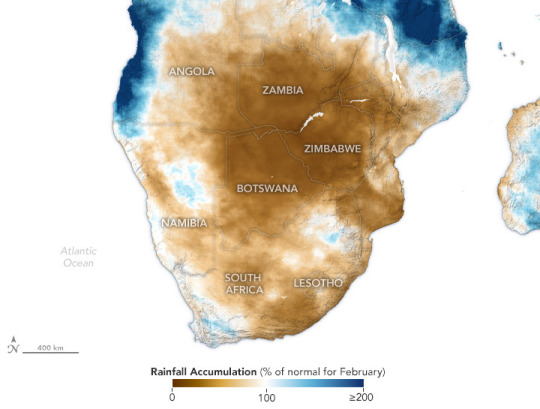
View On WordPress
0 notes
Text
Sfida dei 100 chilometri Namibia per runner aquilano
A inizio novembre ha conquistato
il quarto posto alla 100 chilometri del Sahara, gara di
endurance a tappe, competizione organizzata da Zitoway che ha
raccolto iscritti da Italia, Francia, Argentina, Svizzera,
Belgio, Russia e Ucraina. Per il runner abruzzese, Fabrizio
Dell’Isola ora la sfida è in Africa australe, in Namibia.
Si corre nel deserto del Namib, uno dei più antichi e
affascinanti…
View On WordPress
0 notes
Text
Events 1.16 (after 1930)
1942 – The Holocaust: Nazi Germany begins deporting Jews from the Łódź Ghetto to Chełmno extermination camp.
1942 – Crash of TWA Flight 3, killing all 22 aboard, including film star Carole Lombard.
1945 – World War II: Adolf Hitler moves into his underground bunker, the so-called Führerbunker.
1959 – Austral Líneas Aéreas Flight 205 crashes into the Atlantic Ocean near Astor Piazzolla International Airport in Mar del Plata, Argentina, killing 51.
1969 – Czech student Jan Palach commits suicide by self-immolation in Prague, Czechoslovakia, in protest against the Soviets' crushing of the Prague Spring the year before.
1969 – Space Race: Soviet spacecraft Soyuz 4 and Soyuz 5 perform the first-ever docking of crewed spacecraft in orbit, the first-ever transfer of crew from one space vehicle to another, and the only time such a transfer was accomplished with a space walk.
1979 – Iranian Revolution: The last Iranian Shah flees Iran with his family for good and relocates to Egypt.
1983 – Turkish Airlines Flight 158 crashes at Ankara Esenboğa Airport in Ankara, Turkey, killing 47 and injuring 20.
1991 – Coalition Forces go to war with Iraq, beginning the Gulf War.
1992 – El Salvador officials and rebel leaders sign the Chapultepec Peace Accords in Mexico City, Mexico ending the 12-year Salvadoran Civil War that claimed at least 75,000 lives.
1995 – An avalanche hits the Icelandic village Súðavík, destroying 25 homes and burying 26 people, 14 of whom died.
2001 – Second Congo War: Congolese President Laurent-Désiré Kabila is assassinated by one of his own bodyguards in Kinshasa.
2001 – US President Bill Clinton awards former President Theodore Roosevelt a posthumous Medal of Honor for his service in the Spanish–American War.
2002 – War in Afghanistan: The UN Security Council unanimously establishes an arms embargo and the freezing of assets of Osama bin Laden, al-Qaeda, and the remaining members of the Taliban.
2003 – The Space Shuttle Columbia takes off for mission STS-107 which would be its final one. Columbia disintegrated 16 days later on re-entry.
2006 – Ellen Johnson Sirleaf is sworn in as Liberia's new president. She becomes Africa's first female elected head of state.
2011 – Syrian civil war: The Movement for a Democratic Society (TEV-DEM) is established with the stated goal of re-organizing Syria along the lines of democratic confederalism.
2012 – The Mali War begins when Tuareg militias start fighting the Malian government for independence.
2016 – Thirty-three out of 126 freed hostages are injured and 23 killed in terrorist attacks in Ouagadougou, Burkina Faso on a hotel and a nearby restaurant.
2017 – Turkish Airlines Flight 6491 crashes into a residential area near Manas International Airport in Kyrgyzstan, killing 39 people.
2018 – Myanmar police open fire on a group of ethnic Rakhine protesters, killing seven and wounding twelve.
2020 – The first impeachment of Donald Trump formally moves into its trial phase in the United States Senate.
2020 – The United States Senate ratifies the United States–Mexico–Canada Agreement as a replacement for NAFTA.
1 note
·
View note
Text

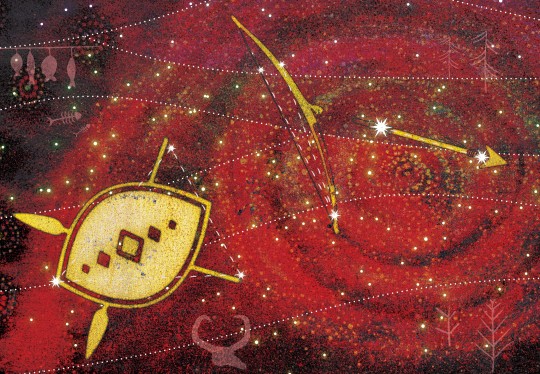
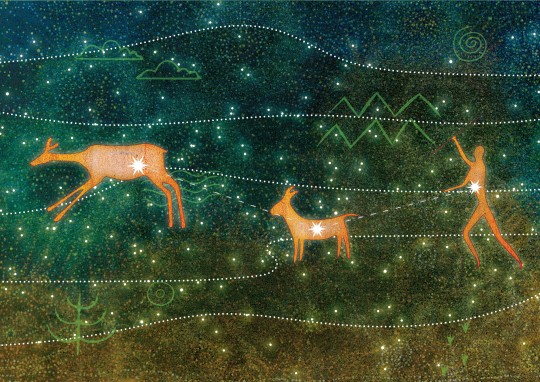
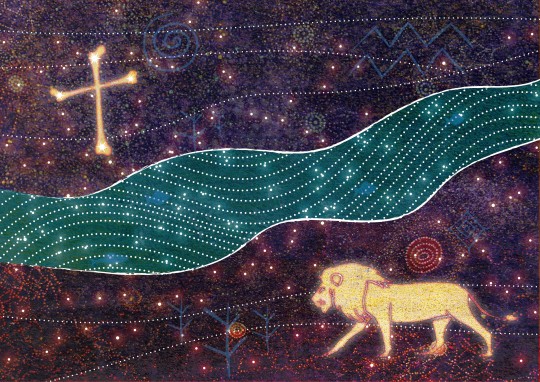
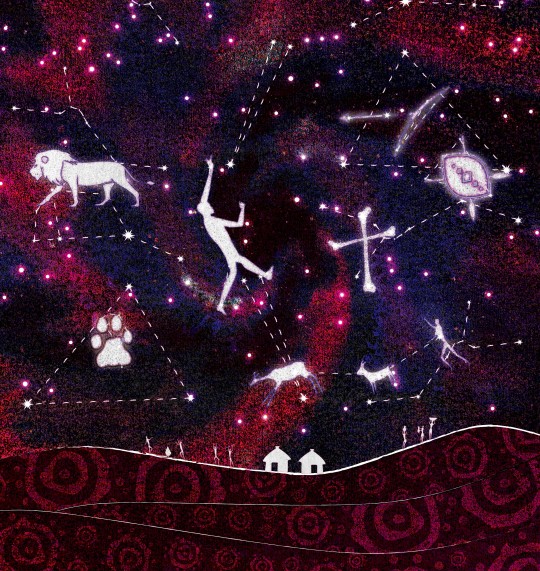

Stars are not just distant specks of light in the African night sky but the guiding lights of mythology, culture, and spirituality.
Indigenous astronomical knowledge is recorded among many African tribes like the Dogon people of Mali, who have rich astronomical knowledge and are said to have made ancient observations of the planetary orbits of Saturn, Mars, Venus and Jupiter with her four major moons.
The traditional astronomical knowledge of the San and Nguni people of Southern Africa is recorded to have guided their agriculture irrigation systems and inspired their religious practices.
In many African societies, navigating life with the guidance of stars has birthed a rich reservoir of practical knowledge useful for timekeeping, agriculture, geography, record keeping and history.
As we explore culture and astronomy from the Chokwe perspective, we must state that we see the skies as we are. Our place on the planet determines our seasons, which affects what heavenly bodies we can observe. Perceptions of star patterns are influenced by the latitude of the observer, and from around 10 degrees south, the Chokwe had the geographical placement to observe and intertwine their star knowledge with their practices and identity.
For the Chokwe, stars tell the story of their people, weaving an intricate tale that forms the fabric of their identity. To the Chokwe, the life of a star is like the story of man, starting with birth, coloured by obstacles and triumph, before ending with the honour of death. The night sky has served as a source of wisdom, a symbol of royalty, and a connection to their revered ancestors.
To learn Chokwe astronomy, we must begin with Tangwa, the sun; Ngonde, the moon's phases; Litota, the stars; and Ntongonoshi, the universe in relation to the stars.
Royalty is a central part of Chokwe culture and is reflected in the sky where we see Ndumba, the lion that walks among the Tulamba - the ancestors, who guide his invisible stride in the Milky Way, leaving paw prints of litota in his path. The Chokwe people refer to the Milky Way as the Mulawiji or the Resting River, and it is used primarily as a star calendar and a compass. This shows an intimate knowledge of the skies as the orientation of the Milky Way changes considerably over the course of the year. Chokwe diviners call the Milky Way the Mulalankungu, which means the King's Road. Nkungu is the name of the great, ancient Chokwe king, and the term refers to him. The Milky Way is a significant part of divination stories, and the diviner's basket, or Ngombo, has objects that represent the stars that the diviner uses as symbols for interpretation.
We are also introduced to Tutumwe Twa Mwanangana, which means 'Child of Wisdom' or 'Sending a Message to the Lord of the Land'. This constellation is depicted as four stars displaying a running, sweating messenger sent to announce the arrival of Mwenga, the new wife represented by the morning star, Venus. We see him spanning across four stars encapsulated in the three constellations of Bootes, Coronae Borealis and Herculis. The four stars, Alphecca, his head; Coronae Borealis accentuating the curve of his powerful hips as he runs; Herculis is his leg extended behind him and in his outstretched hand, Arcturus, the bright message of wisdom.
The beauty of Chokwe cosmology is endless, with serendipitous parallels to Western astronomy. For example, the hunter seen in Orion's Belt is also seen as a hunter by the Chokwe, and they call it Tujita Jita, symbolically interpreted as 'go to fight and always win'. Interestingly, for the Chokwe, the hunter is much closer to his dog in the constellation than in Greek and Egyptian mythology, where the dogs are in separate Canis Minor and Major constellations. Tujilika spans across three modern constellations of Triangulum Australe, Circinus and Centaurus. The symbolic meaning of Tujikila to the Chokwe people is 'the children are protecting you.'
The Nkungu – The Southern Cross represents the ancestors' bones shown by the four brightest stars connected in a cross, and this constellation guides the Mukanda, a circumcision initiation ceremony practised by the Chokwe.
The Seven Sisters, or The Pleiades, are Van Ava Nkungulwila, a lion's claws. Nkungulwila refers to the Nkungu clan and its people, and just as they are together on earth, they are together in the heavens, forming a relationship between heaven, earth, life, and death. The Chokwe see the heavens as their ancestors' home; in their cosmology, when people die, they are reborn in the lion's claws – The Seven Sisters. Considering this belief, it is fascinating to note that astronomers have recognised that this constellation is a star factory where new stars are created as the interstellar gas cloud contracts under the force of gravity. There are reddish stars within the constellation that astronomers recognise as dying stars in a supernova, which the Chokwe recognise as the Nalindele; a star whose season is over and is waning; this story is told in relation to an old wife.
Ancient Chokwe star lore, steeped in symbolism and cultural significance, aligns intriguingly with Western scientific discoveries. It's a reminder that despite diverse perspectives, our shared celestial heritage connects us all.
Modern Zambian society is embracing its traditional star knowledge in exciting ways. Young Zambians blend age-old wisdom with contemporary science and technology, forging a path towards the stars. A brief look can be taken at the enduring legacy of the Zambia Space Program of Edward Nkoloso, who coined the term Afronauts, which has come to embody a time when Zambians were bold and brave about exploring the wondrous mysteries of the universe.
The stars have a unique way of uniting us all, transcending borders, cultures, and time. Our fascination with the night sky is universal, but it's crucial to stay curious and remember that the cosmos is vast and diverse, just like the cultures it inspires. Whether you're gazing at the stars from the Chokwe heartlands of Northwestern Zambia or the bustling streets of Lusaka, we're all part of a timeless story that stretches beyond the horizon of our understanding. The stars above are the same stars that have guided us since time immemorial, reminding us of our shared journey through the great expanse of the universe.
0 notes
Text
Renault SA Talks About The Challenges Faced Due To The EV Shift
Renault SA Managing Director, Tshifularo about his career path, products and Renault SA’s prospects after the 2035 European fossil fuel ban on cars
Shumani Tshifularo hails from a village outside Thohoyandou, Limpopo. He is a chartered accountant and his work experience includes CFO at a local airline, a stint in the heavy machinery leasing sector and posts in several divisions at the Motus Group.
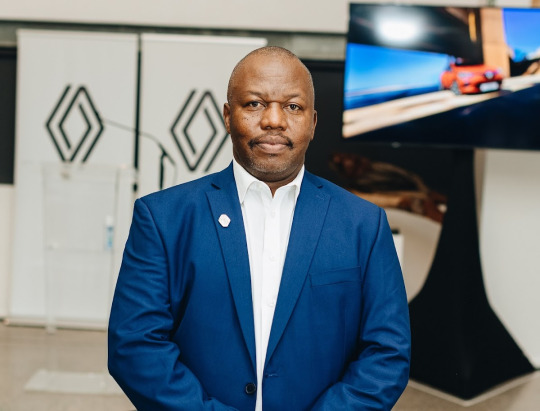
Working his way up
In 2007, Tshifularo was Africa operations MD of Eqstra Fleet Management, and in 2009 he became CFO of Toyota Forklifts — another division — and then MD.
He left the group briefly in 2019 and rejoined Kia SA as its commercial director. The Korean car brand along with Hyundai, Mitsubishi and Renault, form part of the Motus vehicle import division that represents 23 passenger and commercial original equipment manufacturers (OEMs) in SA.
His stint at Kia lasted a year before the coronavirus pandemic hit. Thereafter, he joined Renault SA as commercial director, leading the project to convert and bring to market the Renault Triber Express panel van, among other projects.
In March 2022, he succeeded former Renault SA MD Jaco Oosthuizen who now leads the Motus Group in Australia.

Products
Growing the Renault brand forms a large part of his immediate responsibilities. The company ranks in the top ten best-sellers nationally. The focus is on strengthening model numbers, starting with the new Renault Captur. It’s an important and popular model with SA customers. The Austral SUV, the perfect replacement for the Kadjar, is not confirmed.
Another model in contention is the Renault Oroch, a half-tonne bakkie based on the Renault Duster. Market research continues on this cool-looking yet perplexing bakkie, which is more a lifestyle loader than a workhorse.
“We must ensure that we get the price and positioning correct before deciding if the Oroch gets the green light,” emphasised the MD.
Renault Stellenbosch has covered this topic a number of times and will most likely continue to provide the latest on the Oroch bakkie.
A batch of 55 Megane RS Ultime — the last model to wear the now retired Renault Sport logo — is now available for order, and though production of right-hand drive Alpines has commenced, we could not draw the MD into this topic. Besides, we sought a more interesting local angle. This raises excitement for local Renault dealers like the popular Stellenbosch branch.
Going electric
Efforts to launch the Renault Arkana hybrid in 2024 are at an advanced stage, and this will mark Renault’s first foray into electrified mobility in this market. Dacia is the Romanian-born sister brand of Renault, and it markets a technical twin of the popular Renault Kwid, now with a fully electric version.
Is the brand not picking up on the opportunity to sell affordable electric cars in SA?
Tshifularo says his team is looking at various solutions, but there are challenges, especially load-shedding. He recently commuted in Paris in the all-electric Renault Zoe city car and says there were some issues, mostly non-functioning street-charging stations. So, it seems some European grids also are not coping with demand.
Another challenge with the electric Kwid is pricing. Prices start at €17,000 (R333,000). This is about R100,000 more expensive than even the priciest Kwid in this market. It would be unattainable and pointless to Kwid’s customer base, added the MD.
2035 fossil fuel ban
With Europe set on banning the manufacture of fossil fuel cars by 2035, Tshifularo outlines what he foresees will be the saving grace for markets behind the electric curve. He says the majority of Renaults sold in SA are built and sourced from India, and he anticipates this arrangement will continue beyond 2035.
He says there is talk of some of the Indian assembly plants already planning affordable new energy vehicles by then. Based on these outcomes, perhaps there will be something small, fully electric and suitable for our market conditions.
.
.
.
News shared from https://bonjourrenault.wordpress.com/2023/10/29/renault-sa-talks-about-the-challenges-faced-due-to-the-ev-shift/
0 notes
Photo

Le manchot du Cap peut mesurer entre 60 et 70 cm et pèse entre 2 et 4 kg. Les petits ont le corps recouvert d’un fin duvet gris, lequel tombe durant la puberté (entre 12 et 22 mois) pour laisser place à leur plumage d’adulte. Le manchot du Cap est une espèce endémique d’Afrique australe. Le manchot du Cap est une espèce monogame. Au début du XIXème siècle, on estime que la population de manchots du Cap s’élevait à environs 4 millions d’individus. Ils seraient à peine plus de 55 000 aujourd’hui, leur population ayant presque été réduite à néant par l’activité humaine. Il s’agit désormais d’une espèce protégée classée sur la liste rouge des espèces menacées par l’IUCN . The Cape penguin can measure between 60 and 70 cm and weigh between 2 and 4 kg. The young have their bodies covered with a fine gray down, which falls during puberty (between 12 and 22 months) to give way to their adult plumage. The African penguin is endemic to southern Africa. The African penguin is a monogamous species. At the beginning of the 19th century, it is estimated that the population of Cape penguins amounted to around 4 million individuals. They would be just over 55,000 today, their population having been almost wiped out by human activity. It is now a protected species listed on the IUCN Red List of Threatened Species. . #southafrica #southafrica🇿🇦 #afriquedusud #afrique #africa #manchot #pinguin #beach #capetownsouthafrica #travel #travelphotography #travelgram #travelblogger #travels #voyage #voyageursdumonde #national_geography #nature #naturephotography #naturerey #naturelovers #animales #animallovers #animal #birds #bird #summer #summervibes #goodvibes #happy (à Hout Bay, Western Cape, South Africa) https://www.instagram.com/p/Cphimu-seEh/?igshid=NGJjMDIxMWI=
#southafrica#southafrica🇿🇦#afriquedusud#afrique#africa#manchot#pinguin#beach#capetownsouthafrica#travel#travelphotography#travelgram#travelblogger#travels#voyage#voyageursdumonde#national_geography#nature#naturephotography#naturerey#naturelovers#animales#animallovers#animal#birds#bird#summer#summervibes#goodvibes#happy
41 notes
·
View notes
Text
Angola recebe conferência das companhias aéreas da África Austral
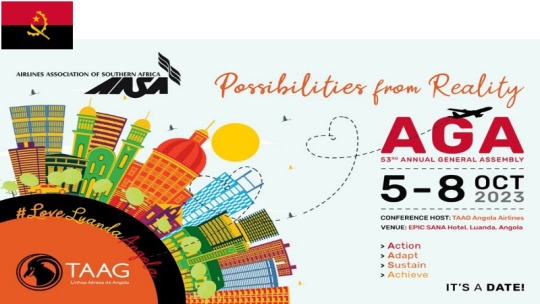
Angola é o país anfitrião da 53ª edição da Assembleia Geral da AASA-Airlines Association of Southern Africa, um evento de referência no setor da aviação e que vai refletir sobre o desenvolvimento da aviação comercial em África.
Este certame, anual, realiza-se pela primeira vez em Angola, reunindo companhias aéreas, reguladores, fabricantes, provedores de serviços, investidores, representações diplomáticas e entidades governamentais.
Este evento é uma plataforma privilegiada de networking e de reforço de relações entre os players da indústria, proporcionando ao ecossistema da aviação angolana, e ao país, a oportunidade de promover as suas valências junto da comunidade internacional.
O dia 06 de outubro, em particular, está reservado para a realização do ciclo de conferências/debate que vai juntar mais de 200 delegados e decisores de topo da indústria da aviação, com várias temáticas em agenda, nomeadamente: ambiente concorrencial, conectividade, financiamento, supply chain, custos operacionais, aspetos regulatórios, crescimento e sustentabilidade das companhias aéreas africanas.
Read the full article
0 notes
Text
Fwd: Other: Requesting.SamplesPhotos.ButterflyMelanitisLeda
Begin forwarded message:
> From: [email protected]
> Subject: Other: Requesting.SamplesPhotos.ButterflyMelanitisLeda
> Date: 23 March 2023 at 05:53:21 GMT
> To: [email protected]
>
>
> Dear Evolutionary Biologists,
>
> We are looking for collaborators to sample common evening brown
> butterflies (Melanitis leda) as part of the NCN-funded project “Success
> of a widespread butterfly: Local adaptation or phenotypic plasticity?”
> https://ift.tt/chgjYSE. This species occurs throughout Africa
> and the Austral-Asian region, and is often common. To reconstruct the
> phylogeography of the species, we are gathering a few specimens on
> ethanol for genomic analysis from sites across the entire range.
>
> We are also interested in documenting colorations of this species
> in different parts of its range. The sampling can be done in natural
> habitats as well as in gardens and plantations. Sampling consists of
> trapping butterflies and photographing them against a standard grey
> card in the field. We are also interested in photographs of collected
> specimens or taken in the wild. We offer co-authorship for time series
> and have funding to supply butterfly traps and grey cards.
>
> If interested, please contact Freerk Molleman at [email protected].
>
> Warm greetings,
>
> Freerk
>
> Freerk Molleman
0 notes
Text
I cambiamenti climatici negli occhi di chi li vive - Mondo
Il ciclone Freddy continua a far paura in Africa australe dopo avere spazzato via interi Paesi e aver ucciso più di 400 persone: la stragrande maggioranza delle quali, 326, nel solo Malawi, almeno 86 in Mozambico e 17 in Madagascar. La furia distruttiva di questa tempesta tropicale, che si è abbattuta due volte in poche settimane nella regione, non ha risparmiato case, strade e infrastrutture,…

View On WordPress
0 notes
Link
Il Ciclone Freddy negli ultimi giorni ha colpito in Africa Australe tra Mozambico, Madagascar e Malawi e ha ucciso oltre 400 persone. #ciclonefreddy #africaaustrale #mozambico #madagascar #malawi #percorsoadanello #fabriziosbardella
0 notes